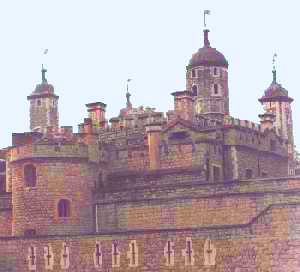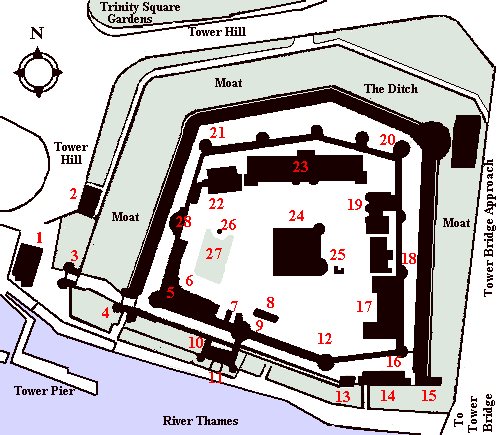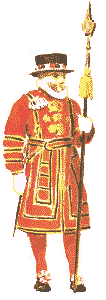| London Town Guide |
Tower of London
| Tower Hill, EC3 Tel: 020 7709 0765 Nearest Tube: Tower Hill The Tower of London is one of London's most famous landmarks, located on the north bank of the River Thames. It is here that you will be able to learn lots about London's history, see the Crown Jewels, have your photo taken next to a Beefeater and admire the famous ravens. The Tower is a designated World Heritage Site and it is one of the most historical buildings in London - in its time it has been a castle, a palace, a prison, an armoury and even a menagerie. Today it is one of the city's most popular tourist sites, attracting over two million visitors each year. |
 |

|
| The oldest part of the tower is the White Tower (24) (the tallest part, located in the centre), which dates back to 1076 and the reign of the Norman King, William the Conqueror. By 1100, it was already a well-established palace, and soon after it homed its very first prisoner - the Bishop of Durham. |
|
During the reigns of Henry III (1216-72) and Edward I (1272-1307) the two outer walls with towers and a moat were built around the white tower in order to provide more defences. These have hardly been altered since then, and so what you see today is the most perfectly preserved medieval fortress in the whole country.
Until Henry III (1216-72) English kings had lived in the White Tower itself, but then Henry built a palace between the White Tower and the river. Kings continued to live at the Tower, in this palace, until the reign of Henry VIII (1509-47) who chose to live in Whitehall Palace in 1529.
After this date, the Tower became increasingly used for its most famous role - as a prison. A list of the Tower's most famous prisoners, from the Bishop of Durham in 1100 to German prisoners in the 1940s, can be seen in the New Armouries building (17).
The Tower of London is also notorious for being the gruesome site where aristocrats were beheaded. In fact only seven people where beheaded at the Tower, their names can be seen on a plaque on Tower Green (27). Most of the prisoners held at the tower were, in fact, eventually set free.
During the late 17th century, the Tower was increasingly used as an armoury and as the storage place for the monarch's coronation regalia. And it was during this period that the public was first admitted to the Tower - so the Tower's current role as a treasury, armoury and tourist attraction actually dates back over 300 years.
Its role as a prison also continued right up to the 20th century, with its most famous prisoner of this century being the Nazi Rudolf Hess, who was held in the Tower in 1941. The last execution at the tower also took place in 1941 when a German spy was shot there.
Today, the White Tower (24) houses part of the Royal Armouries on the ground floor. And on the second floor is the Chapel of St John which is the oldest intact church in London, dating from around 1080.
North of the White Tower are the Waterloo Barracks (23), built in the 19th Century. This is where the Crown Jewels are displayed. The centrepiece of the Crown Jewels is the Imperial State Crown which has a huge number of precious stones, including a 317-carat diamond, set in it. The Crown Jewels are hugely popular and so the number of visitors unfortunately means that the viewing time is restricted. The queues can also be massive, so if you can visit during off-peak season (November-May).
South of the White Tower is the Bloody Tower (7), which gained its name from perhaps the most famous prisoners in the Tower of London's history - the princes in the tower. This is where the child-king Edward V (1483) and his 10-year-old brother were imprisoned by their uncle who was later crowned Richard III (1483-85). The skeletons of two children were found at the tower in 1674, and it has been asserted that these were the remains of the boys - but the true fate of the princes has never been proven.
South of the Bloody Tower is Traitors Gate (11), part of St Thomas's Tower (10). The unfortunate people who were sentenced to a prison spell at the tower were ferried down the River Thames from the law courts of Westminster and then entered the Tower through these gates.
The Tower's famous ravens (8) can also still be seen when you visit. These are in fact the legacy of the Royal Menagerie that was kept at the Tower from the 13th century until the animals were moved to London Zoo in 1831. Legend has it that if the ravens ever leave the Tower, England will fall to her enemies. As a result the ravens have been protected by royal decree for over 300 years and at least six have their wings clipped so that they cannot fly away.
If you are confined to a wheelchair, you will find that access to some parts of the Tower of London is very difficult. Luckily though, the Crown Jewels are accessible by wheelchair.
|
Copyright © 1995 to 2016 Smooth Hound Systems
Smooth Hound Systems accepts no liability with regards to the accuracy of the information on this site.
Users are advised to double check information such as dates, times, prices etc.

